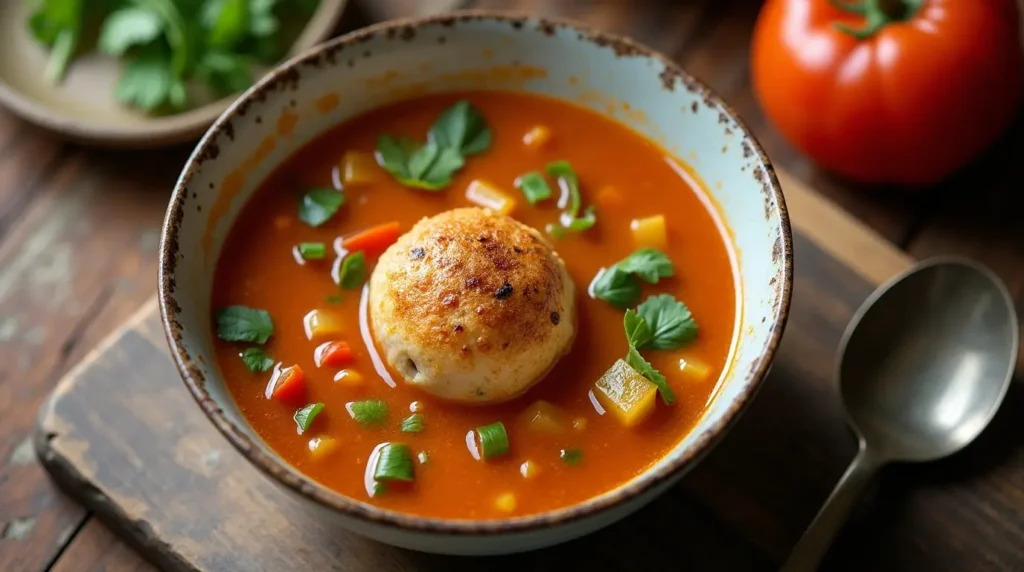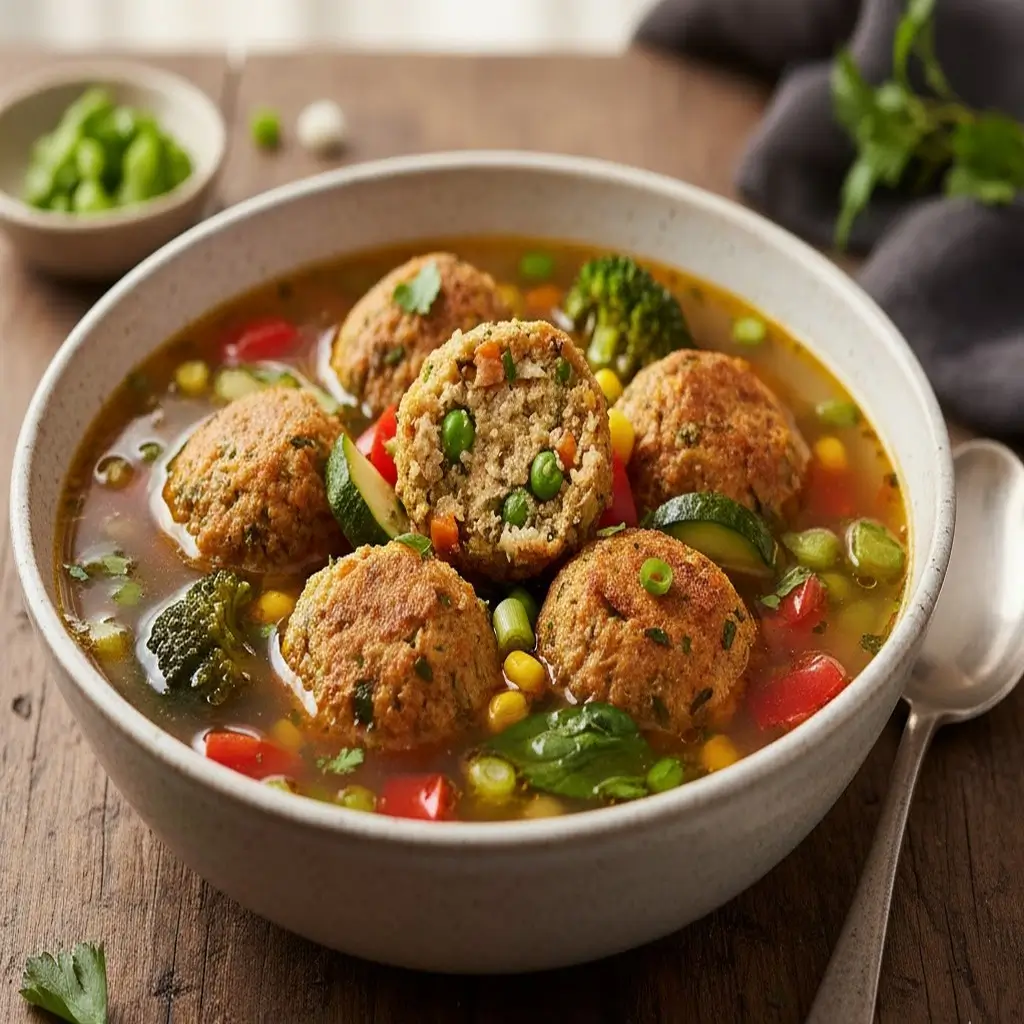This guide explores soup ball vegetables, offering tips, recipes, and serving suggestions for creating hearty and flavorful soups.
Understanding Soup Ball Vegetable Components
A well-crafted soup ball vegetable base is essential for any delicious soup. Therefore, it is crucial to understand the various components. This ensures a flavorful and nutritious final product. The selection of vegetables, their preparation, and the cooking method all play vital roles. Let’s examine these elements closely.
Core Vegetables in Soup Ball Vegetable Mixes
The core of any great soup ball vegetable mix usually includes a few key players. For example, onions, carrots, and celery are commonly used. These provide a foundational flavor base. Consequently, they create a rich and aromatic broth. Additionally, other vegetables like potatoes, turnips, and leeks might be included for added depth. These add both flavor and nutritional value.
The Importance of Freshness and Quality
The quality of your soup ball vegetable ingredients directly affects the final taste. Therefore, using fresh, high-quality vegetables is paramount. Avoid using wilted or bruised produce. This will result in a less flavorful soup. Moreover, washing and prepping vegetables properly is also important. This ensures that any dirt or impurities are removed.
PrintSoup Ball Vegetable Guide
- Total Time: 55 min
- Yield: 4 servings 1x
- Diet: Vegan
Description
A comforting Caribbean-inspired vegetable soup with hearty dough balls (soup balls), simmered in a flavorful broth with root vegetables and herbs.
Ingredients
1 tbsp vegetable oil
1 medium onion, chopped
2 cloves garlic, minced
1 stalk celery, diced
1 medium carrot, chopped
1 small sweet potato, peeled and cubed
1/2 cup pumpkin or butternut squash, cubed
1 small potato, diced
1/2 cup chopped cabbage
1 sprig thyme
1 scallion, chopped
Salt and pepper to taste
6 cups vegetable broth or water
1 cup flour (for soup balls)
1/2 tsp baking powder
1/4 tsp salt
1/3 cup water (or as needed to form dough)
Instructions
1. In a large pot, heat oil over medium heat. Sauté onion, garlic, and celery until softened.
2. Add carrots, sweet potato, squash, and potato. Stir to coat.
3. Pour in the vegetable broth and bring to a boil.
4. Reduce heat, add cabbage, thyme, scallion, salt, and pepper. Let simmer for 10–15 minutes.
5. While soup simmers, make the soup balls: In a bowl, mix flour, baking powder, and salt. Gradually add water to form a soft dough.
6. Pinch off small pieces of dough and roll into balls or flatten slightly.
7. Drop the soup balls into the simmering soup. Cover and cook for 15–20 minutes, or until vegetables and soup balls are cooked through.
8. Taste and adjust seasoning as needed. Serve hot.
Notes
You can add other root vegetables like cassava, eddo, or plantain for variety.
For more flavor, add a dash of curry powder or coconut milk to the broth.
Soup balls can be made in advance and frozen before cooking.
- Prep Time: 20 min
- Cook Time: 35 min
- Category: Soup
- Method: Stovetop
- Cuisine: Caribbean
Nutrition
- Serving Size: 1 bowl
- Calories: 220
- Sugar: 5g
- Sodium: 420mg
- Fat: 5g
- Saturated Fat: 1g
- Unsaturated Fat: 4g
- Trans Fat: 0g
- Carbohydrates: 40g
- Fiber: 6g
- Protein: 5g
- Cholesterol: 0mg
Keywords: vegetable soup, soup balls, dumplings, vegan, Caribbean soup
Preparing Soup Ball Vegetable Mixes
Preparing your soup ball vegetable mix correctly is a critical step. This will impact the texture and flavor of your soup. Therefore, consider these preparation techniques. These techniques will help enhance the overall result.
Chopping and Sizing Vegetables
The size of your chopped vegetables matters. Therefore, aim for uniform sizes. This ensures even cooking. For example, smaller pieces will cook more quickly than larger ones. Consequently, cutting the vegetables into similar sizes will help them soften at the same rate. This promotes even cooking and better flavor blending.
Sautéing for Enhanced Flavor
Sautéing your soup ball vegetable mix before adding broth enhances the flavor. Therefore, heat a little oil in a pot, and sauté your vegetables for a few minutes. This process releases their natural sugars. It also deepens the overall flavor of the soup. Furthermore, it helps the vegetables soften before they are submerged in liquid.
Freezing Soup Ball Vegetable Mixes
If you want to save time, consider preparing and freezing your soup ball vegetable mix. This is a practical option for busy weeknights. Therefore, chop your vegetables, and place them in freezer bags. When you’re ready to make soup, simply add the frozen vegetables to your pot. This time-saving technique helps you make healthy meals easier.
Different Types of Soup Ball Vegetable Combinations
Different types of soup ball vegetable combinations provide varied flavors. Therefore, exploring diverse combinations can transform your soup. Consider these different flavor profiles. They will introduce new tastes to your kitchen.
The Classic Mirepoix
The classic mirepoix is a foundational soup ball vegetable mix. It consists of onions, carrots, and celery. These are usually in a 2:1:1 ratio. Therefore, this blend provides a balanced flavor base for many soups. Its simple but effective combination creates a rich and aromatic broth.
Hearty Root Vegetable Blend
For heartier soups, try a root vegetable blend. This could include carrots, parsnips, potatoes, and turnips. This combination creates a more robust flavor. It also adds a lot of texture and depth. Therefore, this blend is great for winter soups. These vegetables offer earthy and sweet notes.
Mediterranean Style Mix
A Mediterranean-style soup ball vegetable mix adds a unique twist. This might include onions, bell peppers, zucchini, and garlic. Therefore, these ingredients provide a lighter, brighter flavor. They are perfect for summer soups. The combination creates a vibrant and aromatic broth.
Cooking Methods for Soup Ball Vegetable
The method of cooking your soup ball vegetable significantly impacts the outcome. Therefore, you should carefully choose the best cooking technique. Consider these different cooking options. They help enhance the flavors and textures of the vegetables.
Simmering for Flavor Infusion
Simmering is a great method for infusing flavors into your soup. Therefore, add your soup ball vegetable mix to broth. Then, allow it to gently simmer for at least 30 minutes. This process helps the flavors to meld together. It also allows the vegetables to soften completely. Consequently, it will result in a richer and more flavorful soup.
Roasting Before Simmering
Roasting your soup ball vegetable mix before simmering adds a deeper flavor. Therefore, toss your vegetables with a bit of oil and roast until they are slightly caramelized. This process brings out the natural sweetness of the vegetables. Then, add them to the broth. Therefore, the result is a richer and more complex soup.
Pressure Cooking for Speed
For a quicker option, consider using a pressure cooker. This will greatly reduce cooking time. Therefore, add your soup ball vegetable mix and broth to the pressure cooker. This will cook the vegetables much faster. While it may not develop the same level of depth as simmering, it’s a great option for busy days. Consequently, this method is quick and efficient.
Adding Other Ingredients to Your Soup Ball Vegetable
While the soup ball vegetable mix is the foundation, other ingredients enhance the soup. Therefore, consider these additions. They will elevate the overall flavor and texture of your soup.
Protein Options
Adding a protein source transforms your soup into a more substantial meal. Therefore, consider options like chicken, beef, or beans. These ingredients will add flavor and texture. You can use cooked or uncooked protein. Adjust cooking times accordingly. As a result, your soup will be more filling and nutritious.
Herbs and Spices
Herbs and spices add significant flavor. Therefore, experiment with different combinations. Consider fresh herbs like thyme, rosemary, or parsley. Dried spices like cumin, paprika, or chili powder also offer depth. Add them according to your taste. This can dramatically improve the flavor profile. Consequently, spices enhance the overall taste.
Grains and Pasta
Adding grains or pasta makes your soup more hearty. Therefore, consider options like rice, barley, or small pasta shapes. These add texture and help thicken the soup. Keep in mind the cooking time of each grain or pasta. Add them at the appropriate time. Thus, it will help avoid overcooking them.
Recipes Using Soup Ball Vegetable
Let’s explore some recipes that use soup ball vegetable mixes. These recipes will guide you on how to use these mixes effectively. This will result in tasty and satisfying soups.

Classic Chicken Noodle Soup
- Ingredients: Chicken broth, cooked chicken, egg noodles, and a classic soup ball vegetable mix (onions, carrots, celery).
- Instructions: Sauté the soup ball vegetable mix. Add chicken broth. Simmer until vegetables are soft. Add cooked chicken and egg noodles. Cook until noodles are done.
- Notes: This classic soup is comforting and nutritious. The soup ball vegetable mix provides a foundation for flavor. Add fresh herbs like dill or parsley for extra freshness.
Hearty Vegetable and Bean Soup
- Ingredients: Vegetable broth, diced tomatoes, kidney beans, carrots, potatoes, and a basic soup ball vegetable mix.
- Instructions: Sauté the soup ball vegetable mix. Add broth and diced tomatoes. Simmer with potatoes until soft. Add beans, and cook for another 10 minutes.
- Notes: This is a vegetarian and hearty option. The soup ball vegetable base provides a rich flavor. Add a touch of red pepper flakes for a bit of spice. You can also add other vegetables as you wish.
Creamy Tomato Soup
- Ingredients: Canned tomatoes, vegetable broth, cream, a soup ball vegetable base, basil, and garlic.
- Instructions: Roast the soup ball vegetable mix with garlic. Blend with canned tomatoes and vegetable broth. Simmer until heated through. Add cream, and season with fresh basil.
- Notes: This soup is creamy and smooth. The roasted base adds depth. A touch of sugar can balance the acidity of the tomatoes. Serve with grilled cheese sandwiches for a classic pairing.
Serving Suggestions for Soups with Soup Ball Vegetable
The way you serve your soup also makes a difference. Therefore, consider these serving suggestions. These tips will enhance the overall experience.
Garnishes for Visual Appeal
Garnishes enhance the visual appeal of your soup. Therefore, consider adding a sprinkle of fresh herbs. A swirl of cream or a dollop of sour cream can also enhance the appearance. Furthermore, a few croutons will add crunch. Consequently, garnishes enhance the presentation.
Bread and Side Dishes
Pair your soup with appropriate bread or side dishes. Therefore, consider options like crusty bread, garlic bread, or a simple salad. These additions will provide a complete meal. Moreover, they will balance out the soup. Subsequently, it will be a more satisfying meal.
Serving Temperatures
Serving temperature is key to enjoying your soup. Therefore, ensure your hot soups are served hot. Likewise, cold soups should be served chilled. This enhances the flavor of the soup. Consequently, it elevates the dining experience.
Health Benefits of Soup Ball Vegetable
Soup ball vegetables offer numerous health benefits. Therefore, it is important to understand their nutritional advantages. Consider these health benefits that vegetables provide. These benefits contribute to a balanced diet.
Rich in Vitamins and Minerals
Vegetables in soup ball vegetable mixes are rich in vitamins and minerals. Therefore, they provide essential nutrients. For example, carrots are high in vitamin A. Celery is a good source of vitamin K. These nutrients are important for overall health. Consequently, they contribute to a balanced diet.
High in Fiber
Most vegetables are high in fiber. Therefore, the fiber content aids digestion and promotes satiety. This helps prevent overeating. Moreover, fiber also helps regulate blood sugar levels. Consequently, fiber rich foods are beneficial for digestion.
Antioxidant Properties
Many soup ball vegetables contain antioxidants. Therefore, these help combat free radicals in the body. This reduces the risk of chronic diseases. Consequently, this makes them a beneficial addition to any diet. Furthermore, antioxidants help protect the body.
Storing Your Soup Ball Vegetable and Soups
Proper storage is crucial for maintaining freshness. Therefore, ensure both your soup ball vegetable mix and soups are stored correctly. This will help maintain their quality. Let’s look into the best storage practices.
Storing Uncooked Vegetable Mix
Store uncooked soup ball vegetable mixes in airtight containers. Therefore, refrigeration is essential. This will keep them fresh for 2-3 days. If you want to store them longer, freezing is an ideal option. Freezing can extend the shelf life up to several months. Always label the containers for proper identification.
Storing Cooked Soup
Store cooked soup in airtight containers. Then, refrigerate it immediately. Consume it within 3-4 days for optimal freshness. If you need to keep the soup for a longer period, consider freezing it in freezer-safe containers. This allows you to enjoy the soup later. Always cool soup before refrigeration or freezing.
Tips and Tricks for Making the Best Soups
Consider these tips and tricks. They will help you make the best soups using soup ball vegetable mixes. These simple tips will make a big difference.
Using Homemade Broth
Homemade broth can enhance the flavor of your soup. Therefore, if you have time, consider making your own stock from scratch. It adds richness and depth to your soup. It also offers greater control over the salt content. Therefore, homemade broth will make your soup much better.
Adjusting Seasoning as You Go
Seasoning is key to a well-flavored soup. Therefore, taste and adjust the seasoning as you cook. Add salt, pepper, or other herbs as needed. The flavors will develop over time. Therefore, taste periodically. Adjust as necessary to achieve the ideal flavor.
Adding a Touch of Acidity
Adding a touch of acidity can enhance the flavors in your soup. Therefore, try adding a squeeze of lemon juice or a dash of vinegar. This will help balance the flavors. Additionally, it brightens the overall taste. Consequently, it will make a noticeable difference.
Common Mistakes to Avoid When Making Soups
Knowing what to avoid is as important as knowing what to do. Therefore, consider these common mistakes. Avoiding them will help you make better soups.
Overcooking the Vegetables
Overcooking can result in mushy vegetables. Therefore, do not overcook the vegetables in your soup. Cook until they are tender, but still have some texture. This maintains the pleasant texture in your soup. As a result, you get a better overall result.
Using Too Much Liquid
Using too much liquid can dilute the flavor of your soup. Therefore, start with the recommended amount of broth. Add more only if needed. Keep in mind that the vegetables will release some liquid. Therefore, avoid over-diluting your soup.
Not Simmering Long Enough
Simmering helps meld the flavors of your soup. Therefore, do not skip this step. Simmer your soup for an appropriate amount of time. This will allow the flavors to develop fully. Consequently, it will make a richer and more flavorful soup.
FAQs about Soup Ball Vegetable
Let’s address some frequently asked questions about soup ball vegetable mixes. This will help you understand them better. It will also help you use them efficiently.
What Veggies Are in a Soup Pack?
A typical soup ball vegetable pack usually contains onions, carrots, and celery. However, some variations might include other vegetables like potatoes, leeks, or turnips. The combination depends on the intended use of the soup. Therefore, the exact composition may vary. However, onions, carrots, and celery are the most common.
What Are the Best Vegetables to Put in Soup?
The best vegetables for soup include those that provide both flavor and nutrition. Onions, carrots, and celery form a base. Therefore, they provide a balanced flavor. Other great options include potatoes, leeks, turnips, and squash. These vegetables add richness and texture to your soup. Therefore, consider a variety of vegetables.
What Is the Name of the Soup Base Vegetables?
The most common name for soup base vegetables is a mirepoix. It refers to a mix of onions, carrots, and celery. This is the foundational mix used in many soups. However, other similar mixes may exist depending on the specific cuisine. Consequently, mirepoix is the base in many soup recipes.
What Is a Thick Vegetable Soup Called?
A thick vegetable soup is often called a vegetable stew. This indicates a thicker consistency. It usually contains a higher proportion of vegetables compared to liquid. Other names include chowders or pureed vegetable soups. The term indicates that it’s richer and heartier than a standard broth. Consequently, thick soups have different names.
Conclusion
In conclusion, understanding the use of soup ball vegetable mixes is crucial for making flavorful soups. From preparing the base to experimenting with different combinations, there’s much to explore. Therefore, by following the tips and tricks discussed, you can elevate your soup-making skills. A well-made soup ball vegetable mix, proper cooking methods, and creative additions will result in delicious and nutritious soups. As you become more comfortable, you can experiment and make your own perfect soup. Remember that the key is balance, freshness, and your own personal preferences. Ultimately, your soups will be the most flavorful when you explore all the possibilities.
For more fun baking ideas, check out Cookies Dino: The Ultimate Guide to Fun, Safe, and Delicious Baking.

